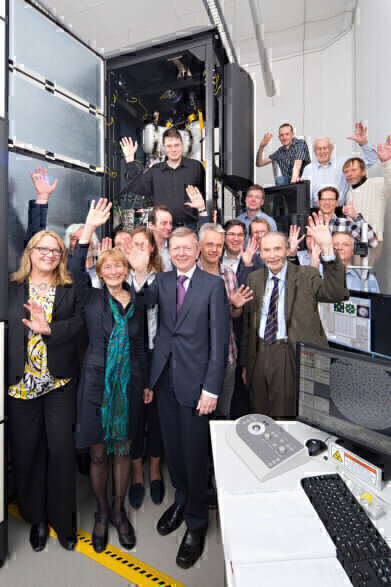News
SALVE Microscope Delivers Atomic Imaging of Radiation Sensitive Samples
Jun 29 2016
FEI and CEOS have recently delivered the first sub-Ångstrom, low-voltage electron (SALVE) microscope to the University of Ulm. The microscope, equipped with a Cc/Cs-corrector from CEOS, was developed in collaboration with the University of Ulm. It uses electrons with energies between 20keV and 80keV, much lower than typical for a transmission electron microscope (TEM), to enhance contrast and reduce radiation damage to light element samples, including two-dimensional (2D) materials like graphene and organic materials. The system corrects both spherical and chromatic aberrations to deliver atomic-scale image resolution and reduces the energy spread of the beam with a monochromator to provide high-energy resolution spectroscopic analysis of composition, electronic structures and bonding states.
We are truly excited to receive this new tool, which is the first of its kind. Our long effort pays off,” said Prof. Ute Kaiser, University of Ulm, head of the SALVE project. “It will allow our researchers to visualize atomic structures with sub-Ångstrom spatial resolution in materials that have, until now, been difficult to investigate because of their sensitivity to damage by the electron beam and their low imaging contrast. We believe it will open the door to ground-breaking discoveries in this important class of materials.”
“We could not have developed this industry-leading microscope without the critical contributions of our partner CEOS and the close interaction with the University of Ulm,” said Bert Freitag, FEI’s director of product marketing for Materials Science. “Excellent teamwork throughout the project and the early-stage development of the correction system by CEOS has allowed us to build the SALVE tool in record time, with initial results that actually exceeded the guaranteed performance specification for low-voltage TEM imaging. In addition to outstanding imaging performance, it supports cryo-EM techniques at liquid nitrogen temperatures and provides high-resolution electron energy loss spectroscopy (EELS) information at low voltages. These capabilities will extend the range of our industry-leading Titan™ Themis TEM platform into entirely new application spaces, such as research on molecules and new 2D materials.”
Prof. Max Haider, CEOS GmbH, adds, “We have had great success with our correctors for spherical aberration at higher voltages. Now we are seeing similar success correcting the chromatic aberrations that limit performance at lower voltages. The SALVE system uses both kinds of correction to deliver unprecedented imaging capability for some very interesting materials that have, until now, not been able to investigate with TEM in atomic resolution.”
The SALVE project is funded by the German Research Society and the Ministry of Science, Research and the Arts Baden-Württemberg. For more information, please visit www.salve-project.de.
Digital Edition
Lab Asia Dec 2025
December 2025
Chromatography Articles- Cutting-edge sample preparation tools help laboratories to stay ahead of the curveMass Spectrometry & Spectroscopy Articles- Unlocking the complexity of metabolomics: Pushi...
View all digital editions
Events
Jan 21 2026 Tokyo, Japan
Jan 28 2026 Tokyo, Japan
Jan 29 2026 New Delhi, India
Feb 07 2026 Boston, MA, USA
Asia Pharma Expo/Asia Lab Expo
Feb 12 2026 Dhaka, Bangladesh



















